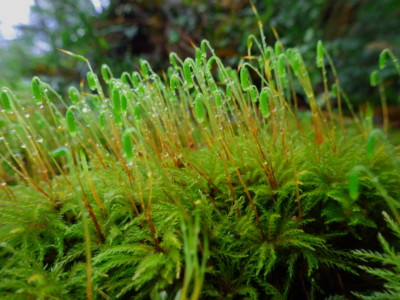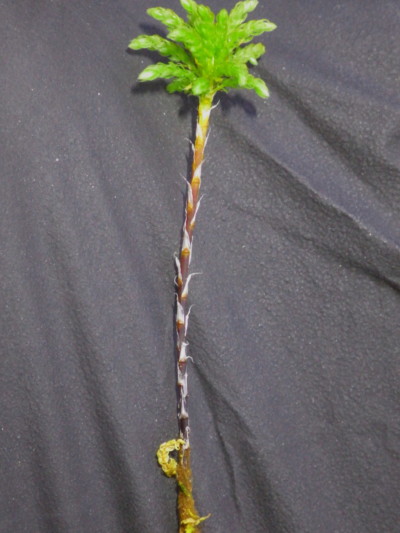Plant Life: Menzies’ Tree Moss
“Little Trees” Everywhere
The Bloedel Reserve’s Moss Garden has more than 50 species of moss and liverworts. Most of them take a bit of searching to find, but several species are more common and, with a little practice, they can be easily identified.
Probably the most common moss variety in the Moss Garden is Menzies’ Tree Moss (Leucolepis acanthoneuron, order Bryales, family Mniaceae). The word “tree” in the name is a clue to its appearance. Look closely and you’ll see immediately see its resemblance to a tree.
A single plant of Menzies’ Tree Moss has a lower “trunk” with several branches at the top. It is often is described as looking similar to a tiny palm tree. The trunk is girded with several white scales (actually just colorless leaves). In fact the genus name Leucolepis means “white scale.” These white scales distinguish this moss from a similar tree moss called Tree Climacium Moss (Climacium dendroides, order Hypnales, family Climaciaceae). The scales on the stem of Tree Climacium Moss are green. So far Tree Climacium Moss has not been spotted at the Bloedel Reserve.
More Than Meets the Eye
The second part of its scientific name — acanthoneuron — means “spiny nerved” or “spiny veined.” This refers to the very tiny spines on the moss leaf veins and edges. This feature, however, is impossible to see with the naked eye. You’ll need a good light and a good magnifier (at least 20x magnification) to see these veins and edges.
Menzies’ Tree Moss was named after Archibald Menzies, a Scottish surgeon, botanist, and naturalist (1754-1842) who did some plant exploration in the Pacific Northwest in the late 1700s, including spending time in the Puget Sound region. Many other plants derive common or scientific names from him including the Douglas Fir (Pseudotsuga menziesii) and the Piggyback Plant (Tolmiea menziesii).
There is even the non-moss genus Menziesia, represented by the Northwest native Menziesia ferruginea, that can be found in the Moss Garden. Sometimes called Rusty Menziesia, False Azalea or Fool’s Huckleberry, M. ferruginea is a shrub that is actually related to rhododendron. In the spring, it bears small orange flowers that resemble huckleberry flowers. Look for this plant on the righthand side of the trail, just past the bench as you are heading towards the Reflection Pool.
Content and photos by Moss Garden Specialist Darren Strenge
SIGN UP FOR OUR ENEWSLETTER
Stay up to date on all of the events and activities taking place at Bloedel Reserve.



